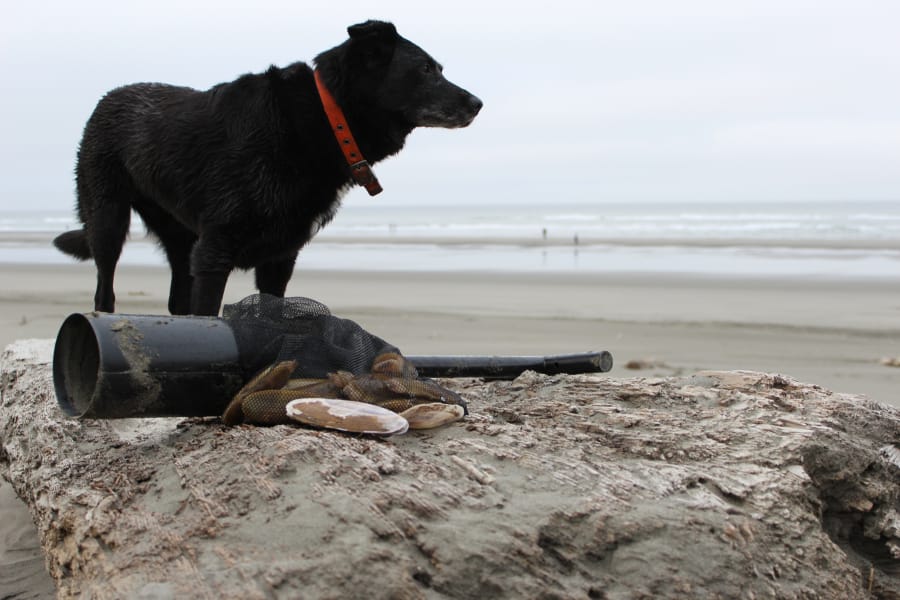Beaches along the Washington coast are chock full of razor clams. According to state fisheries managers, they are abundant in almost record numbers.
And yet, would-be clammers have not been able to dig them since mid-October.
The entire coast is currently closed to razor clams because they contain high levels of domoic acid, a marine neurotoxin that is a product of blooms of algae named Pseudo-nitzchia. These blooms, and the resulting clamming closures, are a result of warming ocean waters.
This phenomenon was never observed until recent decades, but now the blooms are becoming more frequent, and some scientists believe the situation may get worse.
The current outbreak started when a mass of warm water developed along the Washington coast in October. Before that domoic acid levels in the clams were well below the limit. But after Oct. 15, the levels spiked way up to over 100 parts per million, which is five times the allowable limit for the human consumption of razor clams.
As a result, all the scheduled digs for the last two months have been cancelled.
Dan Aryes, the coastal shellfish manager for the WDFW, explained that domoic acid accumulates in the clams over time.
“It binds in the fat,” said Ayres, “and razor clams are fatty, they have a lot of fat, and that’s why we like them.”
Ayres said even after the blooms subside, the toxins hang around. It takes time for the clams to shed the toxins.
Domoic acid does not affect the clams, but when there is a high concentration of it in shellfish humans that eat them may suffer from amnesic shellfish poisoning. The result can be memory loss, emotional and aggressive behavior, brain damage, and even death.
The first ever recorded outbreak of asp occurred in Canada in the mid 1980’s. That led fisheries managers and researchers to look for domoic acid in Washington’s clams. In 1991, they found it in high enough concentrations to close the season.
Whole seasons were cancelled in 1991-92, 1997-98, and 2002-03. There have been shorter closures in 2004-05, and 2015-16.
Ayres said that researchers have found no record of any outbreaks before the mid 1980s. Increasingly, scientists and biologists point to warming oceans as the cause of these outbreaks.
Quinault Nation tribal biologist Joe Schumacher believes that warming on a global scale is driving these events.
“A warming atmosphere equals a warming ocean,” Schumacher said, “and it’s frightening.”
The flip side of the warm waters is that they may have contributed to the high numbers of clams currently along the coast. The warming waters may contain more food for the clams, and that may be driving the high population.
Coastal communities, especially tribal communities, are hit hard when the digging stops. Many businesses depend on clamming dollars, and right now that economic hit is being exasperated by another crisis: the COVID-19 pandemic.
Ayres reports that concern about people gathering in high numbers on local beaches and filtering into local businesses puts coastal communities at risk of the virus spreading.
“That’s why we made the decision along with the counties to open all the beaches or none,” said Ayres. “We did not want people crowding onto one or two beaches.”
That has created a quandary for managers. There are signs that the domoic acid is clearing out quicker up at Kalaloch beach, but if managers open only one beach the crowding could become an issue.
With domoic acid levels as high as they are, will clammers get to harvest any razors this year?
“Yes, there’s actually quite a good chance,” Schumacher said. “It takes a long time for them to depurate (pass the toxins), especially in the winter months since they are putting on tissue and building up body mass, which doesn’t help when they are trying to get rid of toxins.”
However, in spring when spawning occurs, the clams tend to shed the acid fairly quickly. Also, the warm water that caused the algae to bloom has been broken up by storms along the coast, and colder waters have been restored.
“We are officially in a La Nina pattern, and should be back towards normal,” Schumacher added.
However, with rising global temperatures the future of clamming may be clouded, and Schumacher finds that disturbing. It’s not just bad for clam aficionados, but for the communities and businesses that depend on those clamming dollars.
In particular, coastal tribes would suffer. They depend on the clams as a major food source as well as an economic shot in the arm. Tribal members can sell clams commercially, and many do.
When asked whether these domoic acid events could become more common, Schumacher did not demure.
‘Yeah, I think that is a given,” he said. “I don’t see any other path right now.”
A darker question is, could there come a time when razor clams are no longer safe to eat on a permanent basis? The thought is scary, but it is not impossible. However, Schumacher remains optimistic.
“Nature can surprise us all. We like to think we know what’s going on, but then we find ourselves red-faced.”
For more information, check the WDFW razor clams website at: https://wdfw.wa.gov/fishing/shellfishing-regulations/razor-clams
For an accurate and thorough southwest Washington fishing report and forecast by Terry Otto, go to Bob Rees’ ‘The Guides Forecast” at https://www.theguidesforecast.com/



